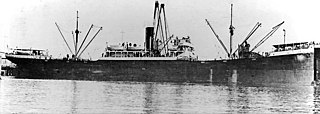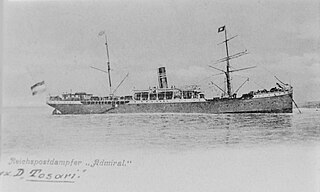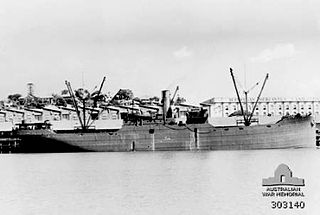Related Research Articles

Jun'yō Maru (順陽丸) was a cargo steamship that was built in Scotland in 1913, served a succession of British owners until 1927, and was then in Japanese ownership until a Royal Navy submarine sank her in 1944.

Ryusei Maru was a cargo steamship that was built in England in 1911 and sunk off the coast of Bali in 1944. Sit was launched as Bra-Kar for Fred. Olsen & Co. of Norway. In 1916 it changed owners and was renamed Havø. In 1935 it changed owners again and was renamed Mabuhay II.

Shin'yō Maru was a cargo steamship that was built in 1894, had a fifty-year career under successive British, Australian, Chinese and Greek owners, was captured by Japan in the Second World War, and sunk by a United States Navy submarine in 1944.

The Isthmian Steamship Company was a shipping company founded by US Steel in 1910.
SS Manistee was an Elders & Fyffes Ltd banana boat that was launched in 1920. She was one of a numerous class of similar banana boats built for Elders & Fyffes in the 1920s.
SS Dundee was a British steamship that was built in Scotland in 1911 and sunk by enemy action in the Celtic Sea in 1917. She was designed as a coastal passenger and cargo liner for the Dundee, Perth & London Shipping Company Ltd, but in 1915 she was converted into an armed boarding steamer for the Royal Navy. She took part in the Action of 16 March 1917, was sunk by a U-boat six months later, and lost members of her crew in both actions.

Seisho Maru was a cargo ship for Mitsui Bussan Kaisho in military service that was sunk by an American submarine during World War II. The ship had been built as SS West Caruth, a cargo ship for the United States Shipping Board (USSB) shortly after the end of World War I. Shortly after completion, the ship was inspected by the United States Navy for possible use as USS West Caruth (ID-2850) but was neither taken into the Navy nor ever commissioned under that name. Before being sold to Japanese owners in 1928, she was also known as SS Exmoor and SS Antonio Tripcovich.
HMS Hilary was a Booth Line passenger steamship that was built in Scotland in 1908 and operated scheduled services between Liverpool and Brazil until 1914. In the First World War she was an armed merchant cruiser (AMC) until a U-boat sank her in the Atlantic Ocean in 1917.

HMS Baralong was a cargo steamship that was built in England in 1901, served in the Royal Navy as a Q-ship in the First World War, was sold into Japanese civilian service in 1922 and scrapped in 1933. She was renamed HMS Wyandra in 1915, Manica in 1916, Kyokuto Maru in 1922 and Shinsei Maru No. 1 in 1925.

SMS Leopard was a British cargo steamship that was built in 1912 as Yarrowdale, captured in 1916 by the Imperial German Navy, converted into a commerce raider in Germany, and sunk with all hands by the Royal Navy in 1917.

SS Wakool was a refrigerated cargo liner that was launched in England in 1898. She belonged to Wilhelm Lund's Blue Anchor Line until 1910, when P&O took over the company. She was a troopship in the Second Boer War from 1899 to 1902. In 1913 a Japanese company bought the ship and renamed her Kwanto Maru. In 1914 she was a Japanese depot ship in the siege of Tsingtao. In 1917 the French government bought her and renamed her Le Myre de Villers. The French government sold her in 1923, and she was scrapped in Italy later that year.
Compañía de Filipinas was a cargo steamship that was built in Scotland in 1890 for the Compañía General de Tabacos de Filipinas (CGTF). In the Philippine–American War the Navy of the First Philippine Republic armed her as its flagship and renamed her Filipinas. After that war she reverted to her original name and commercial service. In the Second World War, Japanese forces captured her and renamed her Hoei Maru. She was sunk in July 1945, shortly before the end of the war.

Rosalind was a steam cargo liner that was launched in England in 1890 for Dampfschiffs Rhederei zu Hamburg as Tosari. In 1891 Deutsche Ost-Afrika Linie (DOAL) bought her and renamed her Admiral. In 1902 the Bowring Brothers' New York, Newfoundland & Halifax Steamship Company bought her and renamed her Rosalind. In 1912 the St Laurence Shipping Company bought her and renamed her City of Sydney. She was wrecked off the coast of Nova Scotia in 1914.

The Design 1023 ship was a steel-hulled cargo ship design approved for mass production by the United States Shipping Board's (USSB) Emergency Fleet Corporation (EFC) in World War I. Like many of the early designs approved by the EFC, the Design 1023 did not originate with the EFC itself but was based on an existing cargo ship designed by Theodore E. Ferris for the United States Shipping Board (USSB). The ships, to be built by the Submarine Boat Corporation of Newark, New Jersey, were the first to be constructed under a standardized production system worked out by Ferris and approved by the USSB.
References
- ↑ "Yarrowdale". Wear Built Ships. Shipping and Shipbuilding Research Trust. Retrieved 18 November 2022.
- ↑ "Boukadra". Tees Built Ships. Shipping and Shipbuilding Research Trust. Retrieved 18 November 2022.
- ↑ "Yarrowdale". Tyne Built Ships. Shipping and Shipbuilding Research Trust. Retrieved 18 November 2022.